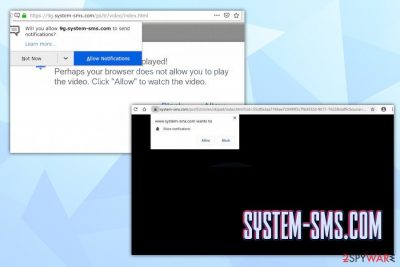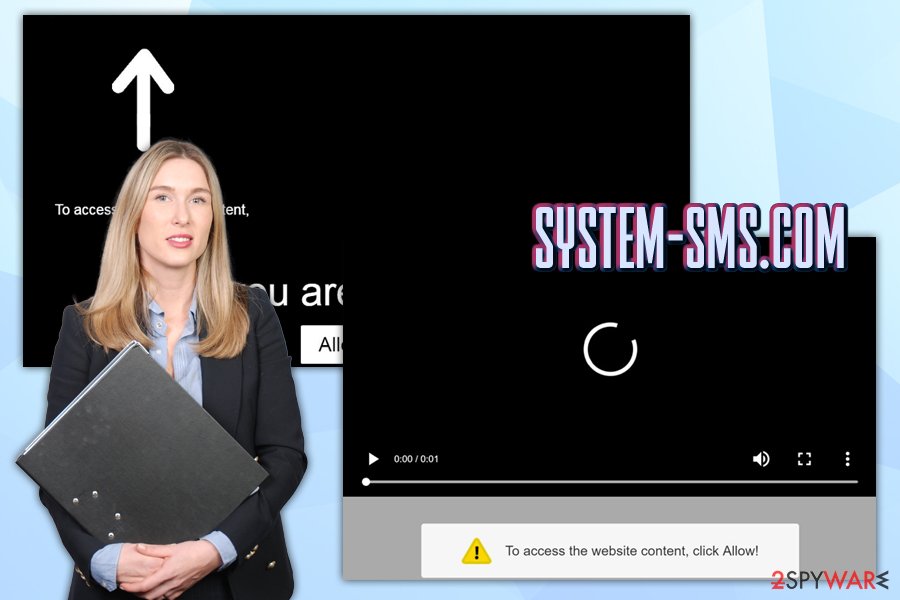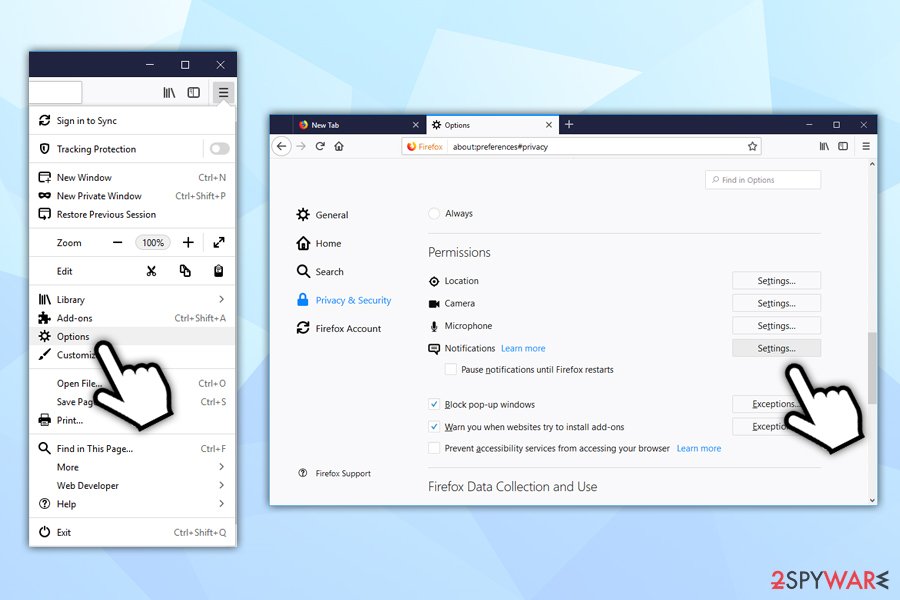System-sms.com (Removal Guide) - Chrome, Firefox, IE, Edge
System-sms.com Removal Guide
What is System-sms.com?
System-sms.com is an insecure website that users might encounter on Google Chrome or any other browser due to PUP infection

System-sms.com is a fraudulent website that is considered to be unsafe by security experts.[1] Once users land on the domain, they are presented with a request to agree to show notifications in order to view a promised video. Site authors use social engineering[2] skills by displaying the following message that implies that the content is X-rated:
If your are 18+, click allow to play the video
However, the appeal is only there in order to make users allow notifications to be shown from System-sms.com, which come in the form of intrusive pop-up ads – these can show up at any time when the computer is on, even if Google Chrome, Mozilla Firefox, Internet Explorer, Safari or any other browser is turned off. As evident, users should not agree to the request, as it will not provide access to the promised video – it will only enable the System-sms.com site to spam ads non-stop.
| Name | System-sms.com |
| Type | Push notification virus |
| Source | If you constantly get redirected to System-sms.com and similar suspicious websites, it might be because of adware installed on your computer |
| Infiltration | Push notifications enabled after visiting the site; adware enters machines with the help of software bundle packages |
| Symptoms | Redirects to suspicious or even dangerous websites, pop-up ads on most visited websites, notifications are shown on the desktop even when the browser is turned off, altered web browser settings, changed homepage and search engine, etc. |
| Dangers | Clicking on links and interacting with unknown content might result in the installation of other PUPs or malware, as well as personal data leak and money loss |
| Termination | To disable System-sms.com ads, refer to the instructions at the bottom section, as well as ways how to reset each of the installed browsers; for adware elimination, you can employ a manual or automatic method |
| Recovery | Use FortectIntego to optimize your computer and fix any virus-affected files |
However, if, among System-sms.com, you run into sites that display offers, deals, banners, in-text links, other ads, or scam messages, there is a high chance that your machine is infected with a potentially unwanted program (adware).[3] In such a case, to remove System-sms.com and other content is shown on your web browsers, you will have to find and terminate the root cause – find all the details at the bottom of this article.
If you allowed System-sms.com notifications to be shown, they could be turned off easily via the web browser settings. Unfortunately, not many users are aware of how to accomplish that, and they are often stuck with unwanted advertisements. This is precisely what the developers of such sites like Facebook-info.com, Topernews.me, Fiterdiloin.pro and System-sms.com count on.
The trick of showing an allegedly to be played video is not the only one that System-sms.com authors might use. In other cases, for example, users might be asked to allow notifications to prove that the visitor is not a robot – it is a commonly used practice by multiple sites in order to prevent bots from accessing it.
In other words, System-sms.com relies on people who are unaware of the push notification feature (it is a legitimate technique and can help users see newly published articles from sites they are interested in) and measures to make them enable it may vary.

System-sms.com removal is not that complicated – all you have to do is disable notifications via your browser. However, if you are noticing some strange browser behavior, you will also have to eliminate all the potentially unwanted programs that were most likely installed behind your back. You can do that by following our guide below or using anti-malware tools. Additionally, if your machine was indeed infected with adware or other PUP, you should reset all installed browsers and scan your computer with FortectIntego to fix virus damage.
Software bundling is a deceptive technique that allows freeware authors to trick you into installing potentially unwanted programs
While users are already aware of the risk of downloading and installing pirated software or using software cracks, most are still unaware that pesky infections like adware are still relatively easy to catch. The lack of attentiveness and users' unwillingness to pay close attention to the installation process of free applications acquired from third-party sources often serve as the main reason for PUPs slipping into machines. What is even worse, that, after the infection, some are unable to understand that they are infected, and keep clicking on links provided by adware. Thus, being oblivious does not help cybersecurity, that is for sure.
here are some tips that will help you stay away from potentially unwanted programs:
- if possible, download the application from official sources (Google web store, Amazon, etc.)
- before installing the app, check out some reviews about it online
- when downloading from third-parties, be wary of optional content clipped to the main installer
- be aware of tricks used to make you install the PUP without noticing: pre-ticked boxes, fine print, deceptive deals/offers, misplaced buttons, etc.
- always opt for Advanced/Custom installation settings instead of Recommended/Quick ones.
Get rid of System-sms.com notifications and adware
System-sms.com removal is depending on whether your machine is indeed infected with adware. Therefore, you should first check the list of the installed applications and get rid of everything you recently installed (unintentionally). If you are unsure how to accomplish that, you can check our instructions below. Even a more straightforward way is to scan your machine with anti-malware software that also incorporates a feature that scans for PUPs – all the unwanted components would be terminated automatically. Optionally, you could also reset all the installed browsers.
If no adware was found but your seeing notifications, you need to remove System-sms.com entry from the allowed list under web browsing settings. Here's how to do that:
Google Chrome
- Pick Menu > Settings
- Scroll down and select Advanced
- Under Privacy and security, click Site Settings > Notifications
- System-sms.com entry should be under Allow section
- Click More Actions and then pick Block
Safari:
- Click Safari > Preferences…
- Under Websites tab, pick Notifications
- Select System-sms.com and then choose Deny
Mozilla Firefox:
- Select Menu > Options
- Choose Privacy & Security section and then go for Notifications

- Pick Settings – you should see System-sms.com entry
- Click on the the drop-down menu and select Block
- Save Changes
MS Edge:
- Click More and pick Settings
- Choose View advanced settings
- Select Advanced
- Click Manage permissions
- Find System-sms.com and turn off notifications
You may remove virus damage with a help of FortectIntego. SpyHunter 5Combo Cleaner and Malwarebytes are recommended to detect potentially unwanted programs and viruses with all their files and registry entries that are related to them.
Getting rid of System-sms.com. Follow these steps
Uninstall from Windows
To get rid of adware app that is bringing you to System-sms.com and similar sites, enter Programs and Features section:
Instructions for Windows 10/8 machines:
- Enter Control Panel into Windows search box and hit Enter or click on the search result.
- Under Programs, select Uninstall a program.

- From the list, find the entry of the suspicious program.
- Right-click on the application and select Uninstall.
- If User Account Control shows up, click Yes.
- Wait till uninstallation process is complete and click OK.

If you are Windows 7/XP user, proceed with the following instructions:
- Click on Windows Start > Control Panel located on the right pane (if you are Windows XP user, click on Add/Remove Programs).
- In Control Panel, select Programs > Uninstall a program.

- Pick the unwanted application by clicking on it once.
- At the top, click Uninstall/Change.
- In the confirmation prompt, pick Yes.
- Click OK once the removal process is finished.
Delete from macOS
Adware is a common problem for Mac users. Proceed with the following and get rid of unwanted apps:
Remove items from Applications folder:
- From the menu bar, select Go > Applications.
- In the Applications folder, look for all related entries.
- Click on the app and drag it to Trash (or right-click and pick Move to Trash)

To fully remove an unwanted app, you need to access Application Support, LaunchAgents, and LaunchDaemons folders and delete relevant files:
- Select Go > Go to Folder.
- Enter /Library/Application Support and click Go or press Enter.
- In the Application Support folder, look for any dubious entries and then delete them.
- Now enter /Library/LaunchAgents and /Library/LaunchDaemons folders the same way and terminate all the related .plist files.

Remove from Microsoft Edge
Delete unwanted extensions from MS Edge:
- Select Menu (three horizontal dots at the top-right of the browser window) and pick Extensions.
- From the list, pick the extension and click on the Gear icon.
- Click on Uninstall at the bottom.

Clear cookies and other browser data:
- Click on the Menu (three horizontal dots at the top-right of the browser window) and select Privacy & security.
- Under Clear browsing data, pick Choose what to clear.
- Select everything (apart from passwords, although you might want to include Media licenses as well, if applicable) and click on Clear.

Restore new tab and homepage settings:
- Click the menu icon and choose Settings.
- Then find On startup section.
- Click Disable if you found any suspicious domain.
Reset MS Edge if the above steps did not work:
- Press on Ctrl + Shift + Esc to open Task Manager.
- Click on More details arrow at the bottom of the window.
- Select Details tab.
- Now scroll down and locate every entry with Microsoft Edge name in it. Right-click on each of them and select End Task to stop MS Edge from running.

If this solution failed to help you, you need to use an advanced Edge reset method. Note that you need to backup your data before proceeding.
- Find the following folder on your computer: C:\\Users\\%username%\\AppData\\Local\\Packages\\Microsoft.MicrosoftEdge_8wekyb3d8bbwe.
- Press Ctrl + A on your keyboard to select all folders.
- Right-click on them and pick Delete

- Now right-click on the Start button and pick Windows PowerShell (Admin).
- When the new window opens, copy and paste the following command, and then press Enter:
Get-AppXPackage -AllUsers -Name Microsoft.MicrosoftEdge | Foreach {Add-AppxPackage -DisableDevelopmentMode -Register “$($_.InstallLocation)\\AppXManifest.xml” -Verbose

Instructions for Chromium-based Edge
Delete extensions from MS Edge (Chromium):
- Open Edge and click select Settings > Extensions.
- Delete unwanted extensions by clicking Remove.

Clear cache and site data:
- Click on Menu and go to Settings.
- Select Privacy, search and services.
- Under Clear browsing data, pick Choose what to clear.
- Under Time range, pick All time.
- Select Clear now.

Reset Chromium-based MS Edge:
- Click on Menu and select Settings.
- On the left side, pick Reset settings.
- Select Restore settings to their default values.
- Confirm with Reset.

Remove from Mozilla Firefox (FF)
Remove dangerous extensions:
- Open Mozilla Firefox browser and click on the Menu (three horizontal lines at the top-right of the window).
- Select Add-ons.
- In here, select unwanted plugin and click Remove.

Reset the homepage:
- Click three horizontal lines at the top right corner to open the menu.
- Choose Options.
- Under Home options, enter your preferred site that will open every time you newly open the Mozilla Firefox.
Clear cookies and site data:
- Click Menu and pick Settings.
- Go to Privacy & Security section.
- Scroll down to locate Cookies and Site Data.
- Click on Clear Data…
- Select Cookies and Site Data, as well as Cached Web Content and press Clear.

Reset Mozilla Firefox
If clearing the browser as explained above did not help, reset Mozilla Firefox:
- Open Mozilla Firefox browser and click the Menu.
- Go to Help and then choose Troubleshooting Information.

- Under Give Firefox a tune up section, click on Refresh Firefox…
- Once the pop-up shows up, confirm the action by pressing on Refresh Firefox.

Remove from Google Chrome
After you eliminate the unwanted program, you should also reset Google Chrome to set settings to default:
Delete malicious extensions from Google Chrome:
- Open Google Chrome, click on the Menu (three vertical dots at the top-right corner) and select More tools > Extensions.
- In the newly opened window, you will see all the installed extensions. Uninstall all the suspicious plugins that might be related to the unwanted program by clicking Remove.

Clear cache and web data from Chrome:
- Click on Menu and pick Settings.
- Under Privacy and security, select Clear browsing data.
- Select Browsing history, Cookies and other site data, as well as Cached images and files.
- Click Clear data.

Change your homepage:
- Click menu and choose Settings.
- Look for a suspicious site in the On startup section.
- Click on Open a specific or set of pages and click on three dots to find the Remove option.
Reset Google Chrome:
If the previous methods did not help you, reset Google Chrome to eliminate all the unwanted components:
- Click on Menu and select Settings.
- In the Settings, scroll down and click Advanced.
- Scroll down and locate Reset and clean up section.
- Now click Restore settings to their original defaults.
- Confirm with Reset settings.

Delete from Safari
Remove unwanted extensions from Safari:
- Click Safari > Preferences…
- In the new window, pick Extensions.
- Select the unwanted extension and select Uninstall.

Clear cookies and other website data from Safari:
- Click Safari > Clear History…
- From the drop-down menu under Clear, pick all history.
- Confirm with Clear History.

Reset Safari if the above-mentioned steps did not help you:
- Click Safari > Preferences…
- Go to Advanced tab.
- Tick the Show Develop menu in menu bar.
- From the menu bar, click Develop, and then select Empty Caches.

After uninstalling this potentially unwanted program (PUP) and fixing each of your web browsers, we recommend you to scan your PC system with a reputable anti-spyware. This will help you to get rid of System-sms.com registry traces and will also identify related parasites or possible malware infections on your computer. For that you can use our top-rated malware remover: FortectIntego, SpyHunter 5Combo Cleaner or Malwarebytes.
How to prevent from getting adware
Stream videos without limitations, no matter where you are
There are multiple parties that could find out almost anything about you by checking your online activity. While this is highly unlikely, advertisers and tech companies are constantly tracking you online. The first step to privacy should be a secure browser that focuses on tracker reduction to a minimum.
Even if you employ a secure browser, you will not be able to access websites that are restricted due to local government laws or other reasons. In other words, you may not be able to stream Disney+ or US-based Netflix in some countries. To bypass these restrictions, you can employ a powerful Private Internet Access VPN, which provides dedicated servers for torrenting and streaming, not slowing you down in the process.
Data backups are important – recover your lost files
Ransomware is one of the biggest threats to personal data. Once it is executed on a machine, it launches a sophisticated encryption algorithm that locks all your files, although it does not destroy them. The most common misconception is that anti-malware software can return files to their previous states. This is not true, however, and data remains locked after the malicious payload is deleted.
While regular data backups are the only secure method to recover your files after a ransomware attack, tools such as Data Recovery Pro can also be effective and restore at least some of your lost data.
























